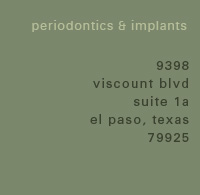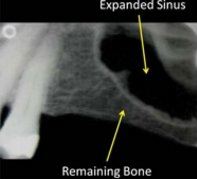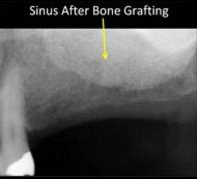- general information
- patient information
- Periodontal Overview
- ––––––––––––––––––––––––––––––––––
- Periodontal Disease and Heart Disease
- Diabetes and Periodontal Diseases
- Periodontal Disease Risk Factors
- Periodontal Complications
- Oral Cancer
- • Biopsy
- Maintaining Periodontal Health throughout a Woman's Lifetime
- Other Diseases and Their Relationship to Periodontal Disease
- Heart Disease: Precautions to be Taken Before Dental Treatment
- Poor Nutrition and Periodontal Disease
- ––––––––––––––––––––––––––––––––––
- What is "Good Oral Hygiene"?
- How to Brush
- How to Floss
- How to Care for Sensitive Teeth
- Hygiene Products
- • Toothbrush Care
- ––––––––––––––––––––––––––––––––––
- New Patient FAQs
- First Visits FAQs
- non-surgical periodontal care
- periodontal therapies
- Traditional Pocket Reduction Therapy
- • Bone Grafting
- ––––––––––––––––––––––––––––––––––
- PerioLase™ LANAP Therapy
- ––––––––––––––––––––––––––––––––––
- Cosmetic Surgery to Improve the Appearance of Your Smile
- • Crown Lengthening to Improve the Esthetics of Your Smile
- • Soft Tissue Grafting to Address Gingival Recession (Root Coverage Grafting)
- Platelet Rich Plasma (PRP)
- Crown Lengthening to Repair a Damaged Tooth
- Exposure / Bracketing of Impacted Tooth
- • Procedure Description for Exposure/Bracketing of Impacted Tooth
- ––––––––––––––––––––––––––––––––––
- Pocket Reduction Surgery FAQs
- Other Therapies FAQs
- dental implants
- Introduction to Dental Implants
- • Single Missing Tooth
- • Two or More Missing Teeth
- • Current Denture User
- • Benefits of Dental Implants
- ––––––––––––––––––––––––––––––––––
- CT Scanner & Comprehensive Implant Planning
- Conscious I.V. Sedation: Is It Right for You?
- ––––––––––––––––––––––––––––––––––
- Socket Preservation Techniques
- Ridge Augmentation and Bone Grafting
- Sinus Graft
- Platelet Rich Plasma
- Routine Implant Maintenance
- our doctors & staff
- office information






Home
Dental Implants
- Introduction to Dental Implants
- • Single Missing Tooth
- • Two or More Missing Teeth
- • Current Denture User
- • Benefits of Dental Implants
- CT Scanner & Comprehensive Implant Planning
- Conscious I.V. Sedation: Is It Right for You?
- Socket Preservation Techniques
- Ridge Augmentation and Bone Grafting
- Sinus Graft
- Platelet Rich Plasma
- Routine Implant Maintenance
Sinus Grafting
Tooth loss in the upper arch of a patient’s mouth presents a unique problem for dentists and surgeons because, in most cases, there is very little vertical bony support remaining after natural teeth are removed, leaving a shallow foundation for dental implants in those regions. The bone in this area is naturally very soft in comparison to bone in other areas of the mouth, providing bone that is the consistency of “Styrofoam” to hold upper implants. This soft bone compares poorly, from a support standpoint, to the bone in the front region of the lower jaw where the bone is as strong and dense as the hardwood “Oak”. Surgeons have tried for years to get around this shallow support problem by placing either angled or short implants to avoid puncturing the maxillary sinus that lies directly above the roots of the upper back teeth. These short implants were often overloaded and failure rates were unacceptable. In the end, patients and their dentists should never lose site of the fact that, “Stress on teeth or implants” must be distributed to enough “Surface Area” to match the load that is placed in the region through daily chewing and functioning. The wider and longer your implants can be – the more stress they will be able to withstand.


The above X-rays show the expanded sinus before and after bone grafting
The maxillary sinuses are located behind your cheeks and on top of the upper teeth. Sinuses are like empty rooms that have nothing in them. The roots of the natural upper teeth are anchored in the jawbone directly below the sinuses and many of these roots actually extend up into the maxillary sinuses. When upper teeth are removed, the sinuses begin to expand into the extraction regions due to the loss of bony stimulation. This eventually leaves a shallow wall of bone separating the maxillary sinus and the mouth. Dental implants, like your natural teeth, need significant amounts of vertical bony support to hold them in place and in the past, the options available to dentists who replaced missing upper posterior teeth, were limited to removable partial dentures.
Fortunately, Dr. Caldwell, Dr. Dimmitt, and other surgeons who have received specialized training in sinus surgery are now able to use predictable surgical techniques that actually “fill the base of the maxillary sinus” with a foundation of stable bone that is able to carry the “stress load” of implant supported bridgework. The statistical success rates for these procedures are excellent and these breakthroughs have provided a means of “reclaiming” this important portion of the mouth, allowing implants as long as 12 to 15mm to be placed in regions where, seven months before, the patient had less than 3 to 5mm of bony support.
Two surgical techniques are utilized to place bone in these deficient regions. The first technique is called a “Sinus Lift” and it involves the passage of bone through the hole that is prepared for the implant placement. This technique is utilized when small volumes of additional support are needed for implant success. The second technique, called a “Lateral Window Sinus Augmentation” involves access to the sinus through a “window in the side of the sinus” that is used for larger graft procedures. Both techniques allow the surgeon to “elevate the sinus lining membrane” away from the remaining bone, creating a “space” that is then filled with bone graft materials. This approach re-establishes a vertical bony foundation that is capable of carrying the load of implants after six to eight months of graft maturation. Implants that are placed in large sinus graft regions are often allowed to integrate for longer periods of time than routine implants, allowing the newly generated bone time to strengthen. Over-all, this technique has provided fixed implant supported bridges or implant retained dentures to be used in a large group of patients who were previously condemned to removable appliances.
If you are interested in discussing regeneration of your compromised bony support and replacement of your missing teeth with an esthetic and naturally functioning smile, ask Dr. Caldwell, Dr. Dimmitt, and their staff to arrange a consultation to start your “First Step” towards ultimate dental health and a new confidence in your natural smile.
9398 Viscount Blvd, Suite 1-A | El Paso, TX 79925 | Tel 915-598-6702 | Fax 915-593-7478
Home | General Information | Patient Information | Non-Surgical Periodontal Care | Periodontal Therapies | Dental Implants | Our Doctors & Staff
Contact Us | Referring Doctors | Disclaimer | Sitemap | Periodontic Website Designby PBHS 2012©